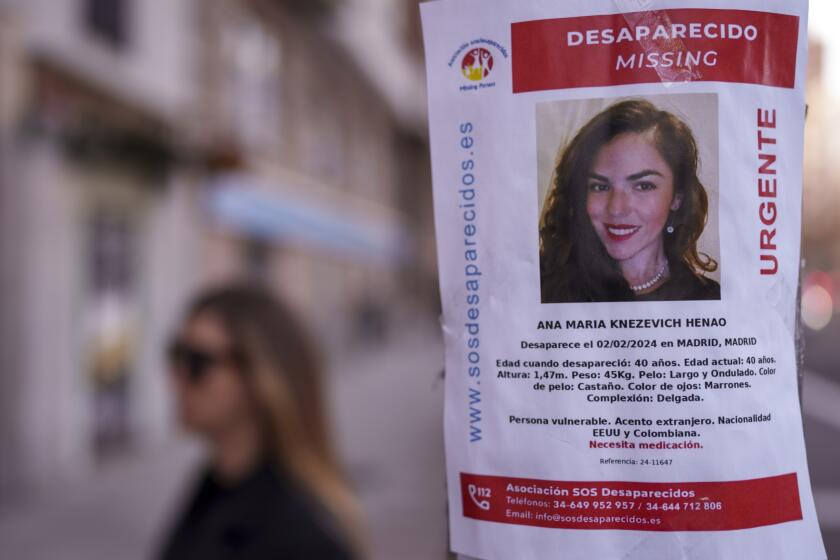U.S. Offers the World’s Oppressed a New Start in Life
War, famine and political turmoil force millions of people to flee their homelands each year. The United States is among the nations worldwide that offer these people -- officially called refugees -- the chance to settle in a new land.
There are about 11.5 million refugees across the globe, according to this year’s World Refugee Survey, published by the U.S. Committee for Refugees and Immigrants, a Washington-based advocacy group.
America’s Refugee Act of 1980 created the Federal Refugee Resettlement Program to aid such people. According to the federal Office of Refugee Resettlement, the U.S. has resettled 2.4 million refugees since 1975, with nearly 77% of them from Indochina or the former Soviet Union.
These refugees represent two groups in which the U.S. has had particularly strong humanitarian and foreign policy interests during the last three decades, government officials said.
Since the enactment of the Refugee Act, annual admissions figures have ranged from 61,000 in 1983 to a high of 207,000 in 1980, according to resettlement office statistics.
The average number admitted annually since 1980 is 98,000, making America the most generous recipient of refugees among industrialized countries.
Question: What is the definition of a refugee?
Answer: Generally, refugees are displaced people who have been admitted to the United States because they are unable or unwilling to return to their home country owing to a well-founded fear of persecution based on their race, religion, nationality, political views or membership in a particular social group.
In 1999, for example, the U.S. designated members of Somalia’s Bantu ethnic group a persecuted group and granted about 12,000 of them the opportunity to move to America.
These onetime slaves were ostracized and marginalized by indigenous Somalis. Somalia’s political instability, social upheaval and clan warfare made it impossible for the Bantus to return home.
Q: What is the difference between a refugee and an asylum-seeker?
A: Refugees apply for entry into the United States from another country outside of their own; asylum-seekers apply for refugee status upon arrival on U.S. soil.
Q: Which countries do refugees come from?
A: Refugees hail from all parts of the world, though sometimes events prompt a surge of applications from a particular country.
In the early 1990s, clan warfare and political turmoil prompted the exodus from Somalia to the West. Recent crises in Iran and Iraq have produced an influx of refugees from those nations.
There is, however, an annual quota for refugees allowed into the U.S. The president determines this number each year in consultation with Congress. The projected figure for fiscal year 2005 was 93,500, according to resettlement office statistics.
Although the U.S. accepts more refugees than any other industrialized nation, advocates say the figure is still small considering the number of people seeking protection globally.
For “the people who do get in here, it’s like they’ve won the lottery,” said Lavinia Limon, president of the U.S. Committee for Refugees and Immigrants, which helps resettle up to 5,000 refugees in America each year.
Q: Where do refugees resettle and how are they assisted on arrival?
A: Refugees are dispersed throughout the country. Michael McKay, department director for refugee and immigrant services at the Catholic Charities Diocese of San Diego, said efforts are made to keep families together and resettle them with relatives.
Sometimes they are settled in a community where compatriots have already planted roots.
For example, there is a significant settlement of Hmong in Fresno, Somalis in San Diego and Vietnamese in Orange County.
“There are efforts to disperse them so that no one city gets overloaded with the responsibility of resettlement,” said McKay, whose agency expects to resettle about 400 refugees this year, most of them from Somalia.
Q: How many refugees have settled in California recently?
A: In federal fiscal year 2004, the figure was 6,749, according to government statistics. The majority of them -- 2,106 -- were natives of Laos. McKay said 1,124 refugees arrived in San Diego County last year. They included Somalis, Ethiopians and Vietnamese.
“It’s a drop in the bucket for the county of San Diego, in terms of absorbing these folks,” said McKay, whose agency is an affiliate of the U.S. Conference of Catholic Bishops, which resettles about 40% of all refugees in America each year. “The majority of them pay taxes and contribute to society.”
Q: Are refugees wholly dependent on U.S. government assistance?
A: The State Department funds several national voluntary agencies to assist with the resettlement of refugees. These agencies work through their local affiliates, who ensure that refugees are met at the airport and provided safe and decent housing with the minimum supplies, such as linen, furniture and basic kitchen appliances.
Newcomers also are helped with essential services such as health screenings, enrollment of children in school and application for Social Security cards.
Refugees receive a minimum of $400 each to help offset their initial expenses. In addition, some are eligible to participate in a federally funded matching grant program that provides housing and living grants for up to four months. Others may qualify for federally funded public assistance during their first eight months in the country.
After this, only families with children are eligible for benefits from the country’s regular welfare program that many U.S. citizens also depend on. Individual states determine how long the refugees can remain on welfare.
Typically, it is five years, volunteer agency officials said.
Q: How much is spent on refugee aid?
A: The U.S. budgeted $484 million to fund refugee services this fiscal year.
But refugees do not get a free ride, agency officials said. They are under pressure to quickly find jobs.
“The idea is to get people working as soon as possible,” Limon said. “The quicker people go to work, the quicker they learn English, the quicker they acclimate, the stronger the families are. Handing out money does not help make strong families.”
Refugees are obliged to repay the cost of their transportation to America within three years, and must establish a payment plan to do so.
McKay, the Catholic Charities official, said this requirement underscores that “refugees come here with the intent of being self-sufficient.”
Q: Can a refugee become a U.S. citizen?
A: Refugees can apply for permanent residency in the U.S. -- a green card -- after they have been in the country for a year. They must wait five years to be eligible for citizenship.
Supporters of refugee resettlement say that despite some difficulties with assimilation, refugees generally contribute to their adopted homeland.
“It’s really like watching America being born over again,” McKay said. “You get people coming here who are like the first settlers, looking for refuge and freedom. It’s satisfying to see people come, and with a little bit of help at first, be able to contribute back and become citizens.”
*
(BEGIN TEXT OF INFOBOX)
Newcomers
California was the point of entry for thousands of refugees last year. Some may have moved on to other states.
Refugee arrivals in California in fiscal 2004
Laos: 2,106
Former Soviet Union: 2,048
Somalia: 685
Iran: 611
Vietnam: 289
Liberia: 248
Ethiopia: 227
Sudan: 118
Afghanistan: 96
Cuba: 80
Burma: 63
Sierra Leone: 45
Columbia: 41
Kenya: 20
Democratic Republic of Congo: 18
Yugoslavia: 18
Eritrea: 8
Iraq: 5
Burundi: 4
Togo: 4
Thailand: 3
Central African Republic: 2
Vietnam (Amerasian): 2
Congo: 1
India: 1
Ivory Coast: 1
Malaysia: 1
Romania: 1
Unknown: 3
Total: 6,749
Source: Office of Refugee Resettlement
More to Read
Start your day right
Sign up for Essential California for news, features and recommendations from the L.A. Times and beyond in your inbox six days a week.
You may occasionally receive promotional content from the Los Angeles Times.







